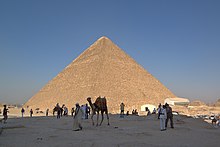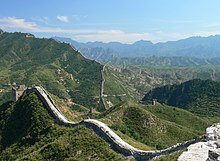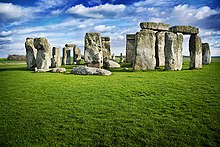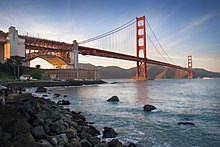"Auto tuning" redirects here. For the principle of automatic correction, see Self-tuning.

Nissan Skyline GT-R (R34)
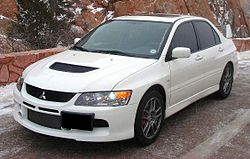
Mitsubishi Lancer Evolution IX
Car tuning is both an industry and a hobby, in which an automobile is modified in order to improve its performance, handling and appearance and improve the owner's driving style. As most vehicles leave the factory set up for average driver expectations and average conditions, tuning has become a way to personalize the characteristics of the vehicle to the owner's preference. For example, they may be altered to provide better fuel economy, produce more power at high RPM or the ride comfort may be sacrificed to provide better handling.
Car tuning is related to auto racing, although most performance cars never compete. Rather they are built for the pleasure of owning and driving such a vehicle. Another major facet of tuning includes performance modification to the car exterior. This includes changing the aerodynamic characteristics of the vehicle via side skirts, front and rear bumpers, adding spoilers, splitters, air vents and light weight wheels.
Origin
In the 1970s and 80s, many Japanese performance cars were never exported outside the Japanese domestic market. In the late 1980s and early 1990s, grey imports of Japanese performance cars, such as the Nissan Skyline
[1][1] [2][3], began to be privately imported into Western Europe and North America. In the United States, this was in direct contrast to the domestic car production around the same time, where there was a very small performance aftermarket for domestic compact and economy cars; the focus was instead on sporty cars such as the Ford Mustang and Chevrolet Corvette, or on classic muscle cars.
Because of their light weight and the increasing availability of low-cost tuning equipment, economy and compact cars exhibit high performance at a low cost in comparison to dedicated sports cars. As professional sporting and racing with such vehicles increased, so did recreational use of these vehicles. Drivers with little or no automotive, mechanical, or racing experience would modify their vehicles to emulate the more impressive versions of racing vehicles, with mixed results.
Also a rise of this class of automobiles into racing scenes was the Rallying competitions, where highly modified tuners race against each other on twisty roads and are timed.This has led to some public styling like on the Impreza models.
During the late '90s, demand for tuning began to spike in many countries with the introduction of a video game franchise by the name of Gran Turismo for the Sony PlayStation. It showed that normal everyday cars could be transformed into high performance vehicles for racing. Also the internet showed people what could be done to their cars and the after market parts scene became wider and more available so people could buy more parts than they had been able to before.The modding tuning side had been around for many years where we see Skylines in races down to the 60's and drifting in the 70's and BMW's tuned and racing from the 60's also just a few cars which were tuned and raced from years ago.
Areas of modification
The essence of modification of a tuner car is an attempt to extract the greatest possible performance—or the appearance of high performance—from the base motor vehicle through the addition, alteration or outright replacement of parts. Although this largely involves modifying the engine and management systems of the vehicle to increase the power output, additional changes are often required to allow the vehicle to handle this power, including stiffened suspension, widened tires, better brakes, improved steering and transmission modifications such as the installation of a short shifter. Although largely invisible from outside the vehicle, certain modifications such as low profile tires, altered suspension, and the addition of spoilers can change the overall appearance of the car.
Audio
Though not related to "tuning", today's society believes that audio has a big part in it. Modern tuners usually do not have elaborate sound systems. The focus of tuning is performance based.
Car problem diagnosis is essential when you want to find out the source of your car problem in order to repair it . It’s important to understand the basic details about how your car works, so you can identify and immediately fix any problems.
Audio is a term used to describe the sound or video system fitted in the vehicle. A stock audio system refers to one that was specified by the manufacturer when the vehicle was built in the factory. A custom audio installation can involve anything from the upgrade of the radio to a full-blown customization based around the audio equipment. Events are held where entrants compete for the loudest, highest quality reception or most innovative sound systems.
Interior
Sanctioned events often require a minimum weight. Just like some well known racing events like NASCAR and NHRA. All cars competing in each class must adhere to a strict set of regulations. Because some are minimum weight requirements, the interior is stripped and lead weights or similar are added to meet that requirement. Roll cages are also difficult to install when the OEM interior is present.
As with weight requirements, safety requirements are present as well. Different classes again play a role. Roll cages, fire extinguishers, reinforced bucket seats, seat harnesses, etc etc.
A common misconception is that a tuner will install flashy lights, useless TV screens and similar items. The fundamentals of tuning is performance and with performance often comes looks.
Engine tuning
Engine tuning is what tuning is all about. An experienced tuner can take a 4 cylinder engine to 1000+ horsepower. There are many 4 and 6 cylinder cars putting out record breaking numbers.
Tuners often opt Turbochargers over superchargers, mostly because of the limits a supercharger imposes at higher RPMs. But superchargers are not uncommon. Naturally aspirated engines can also be tuned.
Some tuners will modify signal to the Engine Control Unit using various devices, to obtain more power. Such devices take input data from sensors and provides the Stock ECU with fictitious data to get the desired result. This is often an inexpensive way to modify an OEM computer system and is usually used as a way to tune lightly modified vehicles. However, this is generally regarded as bad practice.
Today’s car and light truck engines are fully electronically controlled. That makes it very easy to enhance the performance of the engine through “Chip-Tuning”. What that means, is a completely electronically tuning of the engine by modifying the programming of the computer chips, which control the engine management.
Chip tuning is applicable for gasoline as well as for diesel engines provided the engine is equipped with an electronic motor management. That said, engines with turbochargers, compressors or superchargers are the most effective to tune.
Other standalone engine management systems are available. These systems replace factory computers with a user programmable one. Using this device a tuner can decide all running aspects of an engine. Reducing knock, correcting Air Fuel Ratios and advancing/retarding timing to obtain efficient power levels for their setup.
Suspension tuning
Suspension tuning involves modifying the springs, shock absorbers, swaybars, and other related components of a vehicle. Shorter springs offer greater stiffness and a lower center of gravity. Stiffer shock absorbers improve the dynamic weight shifting during cornering and normally have shorter internals to stop them from bottoming out when shorter springs are used. Stiffer sway bars reduce body roll during cornering, thus improving the grip that the tires have on the surface by reducing suspension geometry changes caused by the roll; this also improves handling response due to faster weight shifting (similar to stiffer springs.) The danger with too stiff swaybars is the lifing of the inner wheel which reduces its traction, and the loss of traction happens faster than with softer bars, which requires a more skilful driver to control the car when cornering near the limit. Other components that are sometimes added are strut bars, which improve the body stiffness and help better maintain the proper suspension geometry during cornering. On some cars certain braces, anti-roll bars, etc., can be retrofitted to lower-spec cars from sports models.
For offroad vehicles, the emphasis is on lengthening the suspension travel and larger tires to increase ground clearance.
Though not related, Lowriders with hydraulic/pneumatic suspensions use another unique kind of suspension tuning in which the height of each individual wheel can be rapidly adjusted by system of rams, even to the extent that it is possible to "bounce" the wheels completely clear of the ground.
Body tuning
Body tuning involves adding or modifying spoilers and a body kit. This is done to improve the aerodynamic performance of a vehicle, as in the case of some wings bumper canards, or to lighten the vehicle through replacing bodywork components such as hoods and rear view mirrors with components made from lighter composites such as CFRP. Cornering speeds and adhesion can be improved through the generation of downforce, often at the expense of increased drag.
Often, body modifications are done mainly to improve a vehicle's appearance, as in the case of non-functioning scoops, spoilers, wide arches or any aesthetic modification which offers no benefit to performance. Very rarely does an after market spoiler or body kit improve performance, the majority add weight and increase the drag coefficient of the vehicle and thus can reduce its overall performance. There are aftermarket options available. But a mass of society still only installs equipment for looks.
Increasing the wheel track width through spacers and wide body kits enhance the cars cornering ability. Lowering the center of gravity is another aim of body tuning dealt with via suspension modifications. However, similar to the addition of non-functioning body kits and spoilers, oftentimes suspension tuners unfamiliar with spring dynamics will cut stock springs, producing a soft, bouncy ride. It is also common to lower the car too far, past the optimal center of gravity, purely for appearance.
Competition cars usually have either light weight windows or no windows. Glass is relatively heavy and auto glass is usually thicker than bodywork. Replacing it with plastic saves high up weight, improving almost all performance qualities, at the expense of greatly reduced scratch resistance and therefore service life.
Tires
Since tires have large effects on a car's behavior and are replaced periodically, choosing tires different from the original ones is a very cost effective way to personalize an automobile. Choices include tires for various weather and road conditions, different sizes and various compromises between cost, grip, service life, rolling resistance, handling and ride comfort.
Detuning
Detuning involves returning a modified car to its original factory status. It is akin to automotive restoration. The term
detuning can also refer to the reduction or decrease of performance in a particular area of tuning. An example of this could be where the engine is "detuned" to allow increased traction on a day where the track grip is not sufficient to handle the increased power of the tuned engine.
Styles of modification
Modified cars can be significantly different from their stock counterparts, as a result a common factor among owners/modifiers is to emulate the visual and/or performance characteristics of establshed styles and design principles; though the similarities may not be intentional. As a result, there are now many different styles and visual influences to car modification, some of which are:
- Rat style: The characteristics of the rat rod style of hot rod and custom cars. Usually imitating the appearance of being "unfinished" known of some hot rods in the 40s, 50s and 60s.
- Hot rod style: The characteristics of early hot rods from the 1930s and 1940s. Largely consists of period specific vehicles, components and finishes. May also include the associated styles of Street Rods and Custom cars.
- Modern styles: The recently established modification styles such as the Import scene, Lowriders, European(Euro-style), DUB, Cal Look; most of which are largely visually oriented.
- Cultural/media styles: The characteristics specific to cultures, stereotypes and media such Boy racers and film specific cars; however these characteristics are often largely based on other modification styles. These are often portrayed, developed or even created by various media including films; most notably The Fast and the Furious (film series).
- Production car styles: The characteristics of production vehicles, such as current-model and luxury cars, Sports cars, Supercars and Muscle cars; largely with the intent of improving or updating a vehicles appearance and/or technology to current market preferences.
- Purpose built/racing car styles: The characteristics of racing cars or other purpose built vehicles such as those of Touring car racing, Rallying, Drifting (motorsport) and Drag racing.
Terms
"Streeted" or "Tuner Cars" are Japanese vehicles, such as a Honda Integra DC5, Mitsubishi GTO, Toyota Supra, Nissan Skyline, Mazda RX-7, Subaru Impreza, and the Mitsubishi Lancer Evolution series. These cars are most commonly modified with the more expensive components available. The most popular modifications include suspension upgrades, exhaust systems, and turbos.
If a car is significantly modified from its stock condition, the vehicle may be considered a Custom car. This is a passenger vehicle that has been modified either to improve its performance; often by altering or replacing the engine and transmission, alternatively or additionally the car may be a personal visual statement, or a "style" statement; such as the Rat rod aesthetic.
Legal requirements
Many countries have legal requirements in regard to what car owners can and can't do in relation to vehicle modifications. For example, all vehicles in Victoria, Australia, must conform to construction standards to ensure vehicles provide drivers and passengers with a maximum level of safety.
[4] There are also restrictions for P Plate drivers which can prevent young drivers from driving modified vehicles.
[5]
In the United Kingdom, Australia and the Netherlands it is illegal for any car to have blue lights as they are used by the emergency vehicles.
In Scotland, Germany and Denmark, it is illegal for any car to have neon underlights on a car as it distracts other drivers. In the Netherlands neon is allowed under the car but only when the car is on display; if the car is on a public road, the lights have to be switched off. Many police officers in the U.K are unsure on the exact legislation with regards to under body neons. Most say as long as the bulb is not visible itself then this is legal.
Recently, Belgium issued a new law which describes that bodykit parts need to be approved for safety issues.
In the United States many of these laws are determined at state level and should be reviewed before any modifications.
Sanctioning organizations
Many organizations involved in competitive motorsports establish safety guidelines that far exceed legal requirements placed on civilian street legal vehicles. The NHRA, IHRA and SOLO programs all require that vehicles pass inspection to ensure that all regulations are being complied with.
Clubs
A big part of car modifications are car clubs or groups. Many are specific to particular car manufacturers. Clubs often attend national shows all over the country. There are thought to be over 100 car clubs in the UK.
Popular culture
Speed tuned cars feature in various movies and in songs such as Hot Rod Lincoln.
Tuned cars and custom cars are depicted as well as created by film media, such as those featured in The Fast and the Furious (film series).
